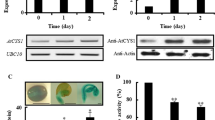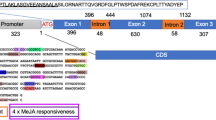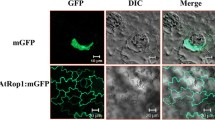Abstract
In Arabidopsis thaliana (L.) Heynh., the cytosolic, patatin-related phospholipase A enzymes comprise a family of ten genes designated AtPLAs thought to be involved in auxin and pathogen signalling [A. Holk et al. (2002) Plant Physiol 130:90–101]. One of these, AtPLA IIA, is investigated here by studying its transcriptional regulation through transgenic Arabidopsis plants containing the AtPLA IIA promoter (PIIA) fused to the β-glucuronidase (GUS) gene. GUS activity appeared in leaves at 10–12 days and became increasingly stronger with age in all leaves. From the same age on, strong GUS activity was visible in the basal stipules of the rosette leaves. PIIA-dependent GUS activity was found in the older parts of the primary root (from 10 days on) and, later in development, in older parts of side roots, and the root cap. No GUS activity was detected in flower organs. PIIA-dependent GUS expression in 12-day-old plants was up-regulated after treatment by salicylic acid, Bion, wounding, 1-aminocyclopropane-1-carboxylic acid (ACC) and jasmonic acid. When transgenic PIIA::uidA plants were grown devoid of iron, 9-day-old plants exhibited increased GUS activity in the leaves and, when devoid of phosphate, 11-day-old plants had increased GUS activity in the roots. In conclusion, this member of the patatin-related phospholipase A gene family showed properties of a defence and iron-stress and phosphate-stress gene, being transcriptionally up-regulated within hours or days.







Similar content being viewed by others
Abbreviations
- AACOCF 3 :
-
Arachidonyltrifluoromethylcarbon
- ACC :
-
1-Aminocyclopropane-1-carboxylic acid
- β-BODIPY-PC :
-
2-(4,4-Difluoro-5-methyl-4-bora-3a,4a-diaza-s-indacene-3-dodecanoyl)-1-hexadecanoyl-sn-glycero-3-phosphocholine
- bis-BODIPY-PC :
-
1,2-Bis-(4,4-difluoro-5,7-dimethyl-4-bora-3a,4a-diaza-s-indacene-3-undecanoyl)-sn-glycero-3-phosphocholine
- ETYA :
-
5,8,11,14-Eicosatetraynoic acid
- GUS :
-
β-Glucuronidase
- HELSS :
-
Tetrahydro-3-(1-naphtalenylnaphthalenyl)-2H-pyran-2-one
- JA :
-
Jasmonic acid
- NDGA :
-
Nordihydroguajaretic acid
- PACOCF 3 :
-
Palmitoyltrifluoromethyl ketone
- PIIA :
-
AtPLA IIA promoter
- PLA :
-
Phospholipase A
- SA :
-
Salicylic acid
References
Ackermann EJ, Conde-Fieboes K, Dennis EA (1995) Inhibition of macrophage Ca2+-independent phospholipase A2 by bromoenol lactone and trifluoromethyl ketones. J Biol Chem 270:445–450
Bechtold N, Ellis J, Pelletier G (1993) In planta Agrobacterium-mediated gene transfer by infiltration of adult Arabidopsis thaliana plants. C R Acad Sci III 316:1194–1199
Becker D, Kemper E, Schell J, Masterson R (1992) New plant binary vectors with selectable markers located proximal to the left T-DNA border. Plant Mol Biol 20:1195–1197
Berleth T, Mattson J, Hartke CS (2000) Vascular continuity and auxin signals. Trends Plant Sci 5:387–394
Borch K, Bouma TJ, Lynch JP, Brown KM (1999) Ethylene: a regulator of root architectural responses to soil phosphorus availability. Plant Cell Environ 22:425–431
Bradford MM (1976) A rapid and sensitive method for the quantification of microgram quantities of protein utilizing the principle of protein–dye binding. Anal Biochem 72:248–254
Conconi A, Miquel M, Browse JA, Ryan CA (1996) Intracellular levels of free linolenic and linoleic acids increase in tomato leaves in response to wounding. Plant Physiol 111:797–803
Devadas SK, Enyedi A, Raina R (2002) The Arabidopsis hrl1 mutation reveals novel overlapping roles for salicylic acid, jasmonic acid and ethylene signaling in cell death and defense against pathogens. Plant J 30:467–480
Dolferus R (1991) Isolation of DNA and RNA from Arabidopsis thaliana. In: Negruku J, Ghark-Chhetri GB (eds) Bio methods, A laboratory guide for cellular and molecular plant biology. Birkhäuser, Basel, pp 133–152
Dhondt S, Gouzerh G, Müller A, Legrand M, Heitz T (2002) Spatio-temporal expression of patatin-like lipid acyl hydrolases and accumulation of jasmonates in elicitor-treated tobacco leaves are not affected by endogenous levels of salicylic acid. Plant J 32:749–762
Falk A, Feys BJ, Frost LN, Jones JDG, Daniels MJ, Parker JE (1999) EDS1, an essential component of R gene-mediated disease resistance in Arabidopsis has homology to eucaryotic lipases. Proc Natl Acad Sci USA 96:3292–3297
Feußner I, Wasternack C (2002) The lipoxygenase pathway. Annu Rev Plant Biol 53:275–297
Hirayama T, Ohto C, Mizoguchi T, Shinozaki K (1995) A gene encoding a phosphatidylinositol-specific phospholipase C is induced by dehydration and salt stress in Arabidopsis thaliana. Proc Natl Acad Sci USA 92:3903–3907
Holk A, Rietz S, Zahn M, Quader H, Scherer GFE (2002) Molecular identification of cytosolic, patatin-related phospholipases A from Arabidopsis with potential functions in plant signal transduction. Plant Physiol 130:90–101
Igarashi M, Demura T, Fukuda H (1998) Expression of the Zinnia TED3 promoter in developing tracheary elements of transgenic Arabidopsis. Plant Mol Biol 36:917–927
Ishiguro S, Kawai-Oda A, Ueda J, Nishida I, Okada K (2001) The DEFECTIVE IN ANTHER DEHISCIENCE gene encodes a novel phospholipase A1 catalyzing the initial step of jasmonic acid biosynthesis, which synchronizes pollen maturation, anther dehiscence, and flower opening in Arabidopsis. Plant Cell 13:2191–209
Jefferson RA, Kavanagh TA, Bevan MW (1987) GUS fusions: beta-glucuronidase as a sensitive and versatile gene fusion marker in higher plants. EMBO J 6:3901–3907
Jirage D, Tootle TL, Reuber L, Frost LN, Feys BJ, Parker JE, Ausubel FM, Glazebrook J (1999) Arabidopsis thaliana PAD4 encodes a lipase-like gene that is important for salicylic acid signaling. Proc Natl Acad Sci USA 96:13583–13588
Jung KM, Kim DK (2000) Purification and characterization of a membrane-associated 48-kilodalton phospholipase A2 in leaves of broad bean. Plant Physiol 123:1057–1067
Kim JY, Chung YS, Ok SH, Lee SG, Chung WI, Kim IY, Shin JS (1999) Characterization of the full-length sequences of phospholipase A2 induced during flower development. Biochim Biophys Acta 1489:389–392
Klessig DF, Durner J, Noad R, Navarre DA, Wendehenne D, Kumar D, Zhou JM, Shah J, Zhang SQ, Kachroo P, Trifa Y, Pontier D, Lam E, Silva H (2000) Nitric oxide and salicylic acid signaling in plant defense. Proc Natl Acad Sci USA 97:8849–8852
Kubigsteltig I, Laudert D, Weiler EW (1999) Structure and regulation of the Arabidopsis thaliana allene oxide synthase gene. Planta 208:463–471
Laemmli UK (1970) Cleavage of structural proteins during the assembly of the head of bacteriophage T4. Nature 227:680–685
Lawton KA, Friedrich L, Hunt M, Weymann K, Delaney T, Kessmann H, Staub T, Ryals J (1996) Benzothiadiazole induces disease resistance in Arabidopsis by activation of the systemic acquired resistance signal transduction pathway. Plant J 10:71–82
Lee S, Suh S, Kim S, Crain RC, Kwak JM, Nam H-G, Lee Y (1997) Systemic elevation of phosphatidic acid and lysophospholipid levels in wounded plants. Plant J 12:547–556
Lee HY, Bahn SC, Kang Y-M, Lee KH, Kim HJ, Noh EK, Palta JP, Shin JS, Ryu SB (2003) Secretory low molecular weight phospholipase A plays important roles in cell elongation and shoot gravitropism in Arabidopsis. Plant Cell 15:1990–2002
López-Bucio J, Hernández-Abreu E, Sánchez-Calderón L, Nieto-Jacobo MF, Simpson J, Herrera-Estrella L (2002) Phosphate availability alters architecture and causes changes in hormone sensitivity in the Arabidopsis root system. Plant Physiol 129:244–256
Mou Z, Fan W, Dong X (2003) Inducers of plant systemic acquired resistance regulate NPR1 function through redox changes. Cell 113:935–944
Mueller MJ, Brodschelm W, Spannagl E, Zenk M (1993) Signaling in the elicitation process is mediated through the octadecanoid pathway leading to jasmonic acid. Proc Natl Acad Sci USA 90:7490–7494
Murashige T, Skoog F (1962) A revised medium for rapid growth and bio assays with tobacco tissue cultures. Physiol Plant 15:473–497
Narváez-Vasquez J, Florin-Christensen J, Ryan CA (1999) Positional specificity of a phospholipase A activity induced by wounding, systemin and oligosaccharide elicitors in tomato leaves. Plant Cell 11:2249–2260
Nishimura A, Morita M, Sugino Y (1990) A rapid and highly efficient method for preparation of competent Escherichia coli cells. Nucleic Acids Res 18:6169
Passarinho PA, Van Hegel AJ, Fransz PF, de Vries SC (2001) Expression pattern of the Arabidopsis thaliana AtEP3/AtchitIV endochitinase gene. Planta 212:556–567
Paul R (1999) Untersuchungen zur Funktion von Phospholipase A2 und Phospholipase C im Signaltransduktionsweg von Auxin und Pilzelicitor in Petersiliezellkulturen. Dissertation, University of Hannover
Paul R, Holk A, Scherer GFE (1998) Fatty acids and lysophospholipids as potential second messengers in auxin action. Rapid activation of phospholipase A2 activity by auxin in suspension-cultured parsley and soybean cells. Plant J 16:601–611
Pieterse CMJ, van Loon LC (1999) Salicylic acid independent plant defense pathways. Trends Plant Sci 4:52–58
Roos W, Dordschbal B, Steighardt J, Hieke M, Weiss D, Laalbach G (1999) A redox-dependent, G-protein-coupled phospholipase A of the plasma membrane is involved in the elicitation of alkaloid biosynthesis in Eschscholtzia californica. Biochim Biophys Acta 1448:390–402
Rosahl S, Schmidt R, Schell J, Willmitzer L (1986) Isolation and characterization of a gene from Solanum tuberosum encoding patatin, the major storage protein of potato tubers. Mol Gen Genet 203:214–220
Rydel TJ, Williams JM, Krieger E, Moshiri F, Stallings WC, Brown SM, Pershing JC, Purcell JP, Alibhai MF (2003) The crystal structure, mutagenesis, and activity studies reveal that patatin is a lipid acyl hydrolase with a ser-asp catalytic dyad. Biochemistry 42:6696–6708
Schaller F (2001) Enzymes of the biosynthesis of octadecanoid-derived signalling molecules. J Exp Bot 52:11–23
Schenk PM, Kazan K, Wilson I, Anderson JP, Richmond T, Somerville SC, Manners JM (2000) Coordinated plant defense responses in Arabidopsis revealed by microarray analysis. Proc Natl Acad Sci USA 97:11655–11660
Scherer GFE (2002) Secondary messengers and phospholipase A2 in auxin signal transduction. Plant Mol Biol 49:357–372
Scherer GFE, André B (1989) A rapid response to plant hormone: auxin stimulates phospholipase A2 in vivo and in vitro. Biochem Biophys Res Commun 163:111–117
Scherer GFE, André B (1993) Stimulation of phospholipase A2 by auxin in microsomes from suspension cultured soybean cells is receptor-mediated and influenced by nucleotides. Planta 191:515–523
Scherer GFE, Arnold B (1997) Auxin-induced growth is inhibited by phospholipase A2 inhibitors. Implications for auxin-induced signal transduction. Planta 202:462–469
Scherer GFE, Paul RU, Holk A, Martinec J (2002) Down-regulation by elicitors of phosphatidylcholine-hydrolyzing phospholipase C and up-regulation of phospholipase A in plant cells. Biochem Biophys Res Commun 293:766–770
Schmidt W, Schikora A (2001) Different pathways are involved in phosphate and iron stress induced alterations of root epidermal cell development. Plant Physiol 125:2078–2084
Schmidt W, Tittel J, Schikora A (2000) Role of hormones in the induction of iron deficiency responses in Arabidopsis roots. Plant Physiol 122:1109–1118
Sowka S, Wagner S, Krebitz M, Arija-Mad-Arif S, Yusof F, Kinaciyan T, Brehler R, Scheiner O, Breiteneder H (1998) cDNA cloning of the 43-kDa latex allergen Hev b7 with sequence similarity to patatins and its expression in the yeast Pichia pastoris. Eur J Biochem 255:213–219
Ståhl U, Ek B, Stymne S (1998) Purification and characterization of a low-molecular-weight phospholipase A2 from developing seeds of elm. Plant Physiol 117:197–205
Street IP, Lin H-K, Laliberté F, Ghomashchi F, Wang Z, Perrier H, Tremblay NM, Huang Z, Weech PK, Gelb MH (1993) Slow- and tight-binding inhibitors of the 85-kDa human phospholipase A2. Biochemistry 32:5935–5940
van Haute, Joes H, Warren G, Van Montagu M, Schell J (1983) Intergeneric transfer and exchange recombination of restriction fragments cloned in pBR322: a novel strategy for the reversed genetics of the Ti-Plasmid of Agrobacterium tumefaciens. EMBO J 2:411–417
van Wees SC, de Swart EA, van Pelt JA, van Loon LC, Pieterse CM (2000) Enhancement of induced disease resistance by simultaneous activation of salicylate- and jasmonate-dependent defense pathways in Arabidopsis thaliana. Proc Natl Acad Sci USA 97:8711–8716
Viehweger K, Dordschbal B, Roos W (2002) Elicitor-activated phospholipase A2 generates lysophosphatidylcholines that mobilize the vacuolar H+ pool for pH signaling via the activation of Na+-dependent proton fluxes. Plant Cell 14:1509–1525
Wang X (1999) The role of phospholipase D in signaling cascades. Plant Physiol 120:645–651
Winstead MV, Balsinde J, Dennis EA (2000) Calcium-independent phospholipase A2: structure and function. Biochim Biophys Acta 1488:28–39
Acknowledgements
This work was supported by the Deutsche Forschungsgemeinschaft (Sche 207/9-1), the Bundesministerium für Forschung (50WB0010), and the Deutsche Volkswagen Stiftung [A.Z.51.16-76251-9/97(ZN607)].
Author information
Authors and Affiliations
Corresponding author
Rights and permissions
About this article
Cite this article
Rietz, S., Holk, A. & Scherer, G.F.E. Expression of the patatin-related phospholipase A gene AtPLA IIA in Arabidopsis thaliana is up-regulated by salicylic acid, wounding, ethylene, and iron and phosphate deficiency. Planta 219, 743–753 (2004). https://doi.org/10.1007/s00425-004-1275-9
Received:
Accepted:
Published:
Issue Date:
DOI: https://doi.org/10.1007/s00425-004-1275-9




